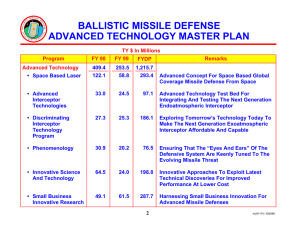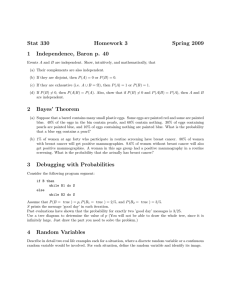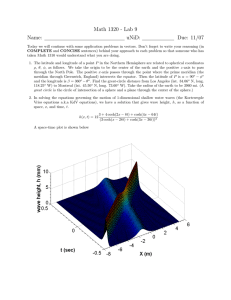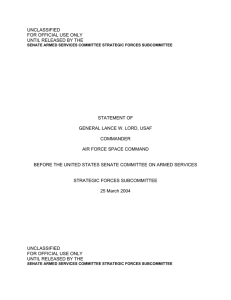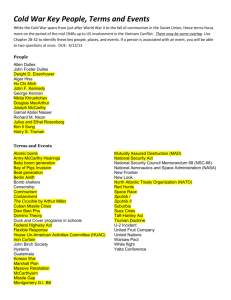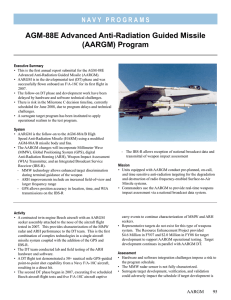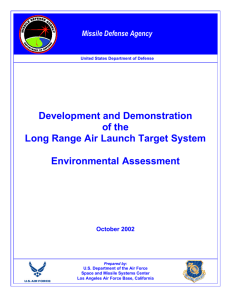FINDING OF NO SIGNIFICANT IMPACT (FONSI) DEVELOPMENT AND DEMONSTRATION OF THE
advertisement
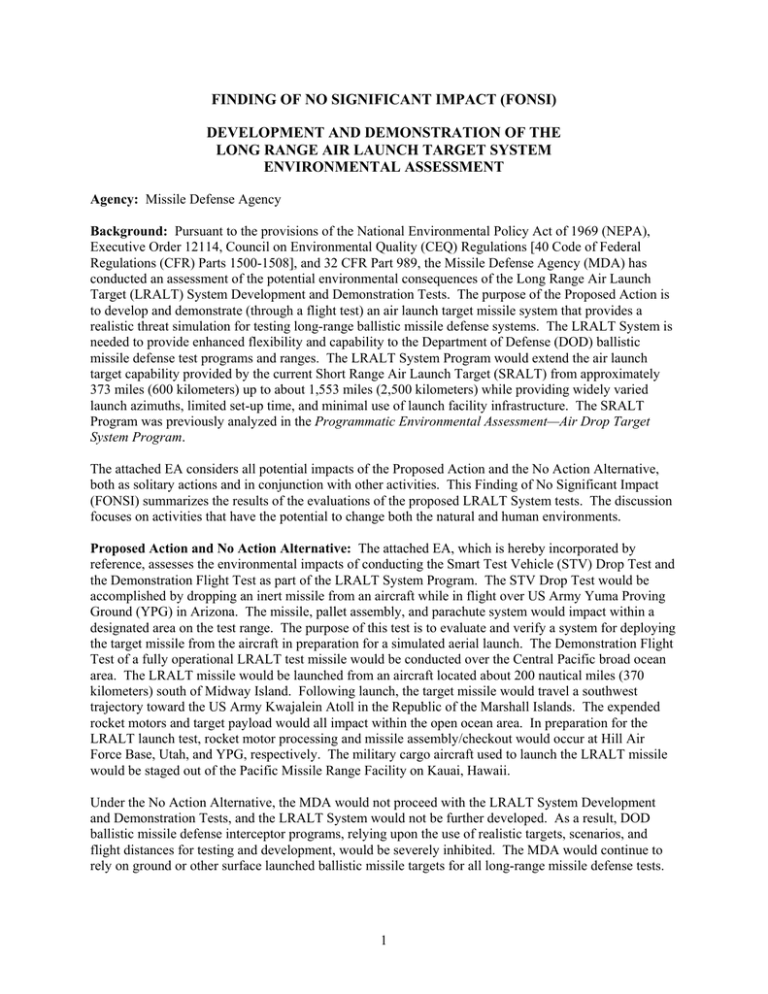
FINDING OF NO SIGNIFICANT IMPACT (FONSI) DEVELOPMENT AND DEMONSTRATION OF THE LONG RANGE AIR LAUNCH TARGET SYSTEM ENVIRONMENTAL ASSESSMENT Agency: Missile Defense Agency Background: Pursuant to the provisions of the National Environmental Policy Act of 1969 (NEPA), Executive Order 12114, Council on Environmental Quality (CEQ) Regulations [40 Code of Federal Regulations (CFR) Parts 1500-1508], and 32 CFR Part 989, the Missile Defense Agency (MDA) has conducted an assessment of the potential environmental consequences of the Long Range Air Launch Target (LRALT) System Development and Demonstration Tests. The purpose of the Proposed Action is to develop and demonstrate (through a flight test) an air launch target missile system that provides a realistic threat simulation for testing long-range ballistic missile defense systems. The LRALT System is needed to provide enhanced flexibility and capability to the Department of Defense (DOD) ballistic missile defense test programs and ranges. The LRALT System Program would extend the air launch target capability provided by the current Short Range Air Launch Target (SRALT) from approximately 373 miles (600 kilometers) up to about 1,553 miles (2,500 kilometers) while providing widely varied launch azimuths, limited set-up time, and minimal use of launch facility infrastructure. The SRALT Program was previously analyzed in the Programmatic Environmental Assessment—Air Drop Target System Program. The attached EA considers all potential impacts of the Proposed Action and the No Action Alternative, both as solitary actions and in conjunction with other activities. This Finding of No Significant Impact (FONSI) summarizes the results of the evaluations of the proposed LRALT System tests. The discussion focuses on activities that have the potential to change both the natural and human environments. Proposed Action and No Action Alternative: The attached EA, which is hereby incorporated by reference, assesses the environmental impacts of conducting the Smart Test Vehicle (STV) Drop Test and the Demonstration Flight Test as part of the LRALT System Program. The STV Drop Test would be accomplished by dropping an inert missile from an aircraft while in flight over US Army Yuma Proving Ground (YPG) in Arizona. The missile, pallet assembly, and parachute system would impact within a designated area on the test range. The purpose of this test is to evaluate and verify a system for deploying the target missile from the aircraft in preparation for a simulated aerial launch. The Demonstration Flight Test of a fully operational LRALT test missile would be conducted over the Central Pacific broad ocean area. The LRALT missile would be launched from an aircraft located about 200 nautical miles (370 kilometers) south of Midway Island. Following launch, the target missile would travel a southwest trajectory toward the US Army Kwajalein Atoll in the Republic of the Marshall Islands. The expended rocket motors and target payload would all impact within the open ocean area. In preparation for the LRALT launch test, rocket motor processing and missile assembly/checkout would occur at Hill Air Force Base, Utah, and YPG, respectively. The military cargo aircraft used to launch the LRALT missile would be staged out of the Pacific Missile Range Facility on Kauai, Hawaii. Under the No Action Alternative, the MDA would not proceed with the LRALT System Development and Demonstration Tests, and the LRALT System would not be further developed. As a result, DOD ballistic missile defense interceptor programs, relying upon the use of realistic targets, scenarios, and flight distances for testing and development, would be severely inhibited. The MDA would continue to rely on ground or other surface launched ballistic missile targets for all long-range missile defense tests. 1 Environmental Effects: Potential environmental effects associated with the Proposed Action and No Action Alternatives were assessed for the following environmental resources: air quality, biological resources, cultural resources, hazardous materials and waste management, airspace, and health and safety. Other resource areas, including land use, socioeconomics, and soil resources, were not analyzed further because no impacts to those resources are anticipated as a result of implementing the Proposed Action. No new environmental impacts would be anticipated from the No Action Alternative because the use of ground or other surface launched target systems would be a continuation of existing activities. • Air Quality. Although the emissions from the LRALT’s two rocket motors would include criteria pollutants under the Clean Air Act, as well as a listed hazardous air pollutant, no inhabited land areas would be near the launch site, and the chemicals would be rapidly diluted and dispersed by prevalent winds. Thus, no significant impacts to air quality in the test area are expected. From a global perspective, the emissions released into the upper atmosphere by the LRALT missile would add to the overall global loading of chlorine and other gases that contribute to long-term ozone depletion. The amount of emissions released, however, represents such an extremely small percentage of the total loading, that these emissions are not statistically significant to the cumulative impact on stratospheric ozone layer. • Biological Resources. Potential impacts to biological resources from the proposed LRALT tests include such possibilities as sound disturbances from launch noise and sonic booms, direct contact and shock wave from the splashdown of missile components in the ocean, contact and entanglement with the LRALT pallet and parachute, and contamination of seawater. Noise disturbance to marine mammals is the subject of ongoing scientific investigation. Considering the LRALT flight test is a single, localized event, and that only small numbers of marine mammals and sea turtles would be in the affected areas, it is expected that resulting impacts from launch noise and sonic boom overpressures would be minimal and not significant. The potential striking of a marine mammal or sea turtle by missile component splashdown or falling debris is extremely unlikely, given the large area of water in the affected area and the typical low density of animals in a specific ocean area at a given time. Entanglement and drowning of a marine mammal or sea turtle in a parachute would be unlikely, since a parachute would either have to land directly on an animal, or an animal would have to swim blindly into it before it sinks to the ocean floor. Although toxic compounds from LRALT components could affect animals within the immediate vicinity of splashdown or debris sites, the components would immediately sink, allowing any contaminants released to be rapidly diluted. Biological resources at YPG are managed and protected in accordance with all applicable Federal and state regulations, and installation guidelines. The limited extent of activity from LRALT test operations at YPG is not expected to have any long-term or significant effects, including any cumulative effects, on animal populations or vegetation. • Cultural Resources. At YPG, the STV Drop Test could potentially disturb archaeological sites through direct impact or equipment recovery operations. However, it is very unlikely that the air dropped test equipment would land on an archaeological site, since the sites are relatively small in size and scattered over a broad area. In addition, various precautions would be taken to avoid disturbance of recorded archaeological sites during ground recovery operations. Considering that the STV Drop Test is a single event, little or no impact to the archaeological sites at YPG is expected. • Hazardous Materials and Waste Management. Hazardous materials and wastes used and generated during the course of the LRALT System tests would be managed in accordance with applicable Federal and state regulations, and DOD service guidelines. Although slight, there is a potential for chemical or fuel spills or mishaps during processing, transportation, and launch operations. Because 2 any spills or mishaps would be handled pursuant to all applicable Federal and state laws, and DOD regulations, no significant impacts from hazardous materials or waste management are anticipated. • Airspace. LRALT test activities would be coordinated with the Federal Aviation Administration (FAA) to minimize impacts to airspace use. The airspace proposed for use in the open Pacific Ocean area is not heavily used by commercial aircraft and is far removed from the en route airways and jet routes crossing the Pacific. Notices to Airmen would be issued before testing, and affected airspace would be surveyed by radar and patrol aircraft prior to missile launch. Because missile tests would be coordinated with the FAA and airspace use areas would be patrolled prior to testing, no significant impacts to airspace use are expected. • Health and Safety. All LRALT activities would be accomplished in accordance with applicable DOD, Federal, and state health and safety standards. Through adherence to DOD standards for risk criteria during the Demonstration Flight Test over the Pacific, individuals of the general public would not be exposed to a probability of fatality greater than 1 in 10 million. Range safety officials would also issue Notices to Airmen, as well as to Mariners, and the missile hazard zones would be determined clear of both aircraft and surface vessels before proceeding with the flight test. By following established safety standards and procedures at all LRALT test locations, the level of risk to military personnel, contractors, and the general public is greatly reduced. As a result, no impacts to public or occupational health and safety are expected. Conclusion: Based upon review of the facts and analyses contained in the attached Environmental Assessment, it is concluded that implementation of the Proposed Action will not have a significant environmental impact, either by itself or cumulatively with other projects. Accordingly, the requirements of NEPA, the CEQ Regulations, and 32 CFR Part 989 are fulfilled and an Environmental Impact Statement is not required. An availability notice for public review was published in local newspapers for each test support location on or before October 18, 2002, initiating a 15-day review period which ends on November 1, 2002. Copies of the EA and Draft FONSI were made available in local libraries or offices in Arizona, Hawaii, Utah, and in the Republic of the Marshall Islands. The EA and Draft FONSI also appeared on the Space and Missile Systems Center, Los Angeles Air Force Base web site at http://ax.losangeles.af.mil/axf. The point of contact for questions and information is Mr. Thomas Huynh, LRALT Environmental Manager. He can be reached by calling (310) 363-1541, by facsimile at (310) 363-1503, or by e-mail at Thomas.Huynh@losangeles.af.mil. The signing of this FONSI completes the MDA’s environmental analysis process for the Development and Demonstration of the LRALT System. Approved: 3

